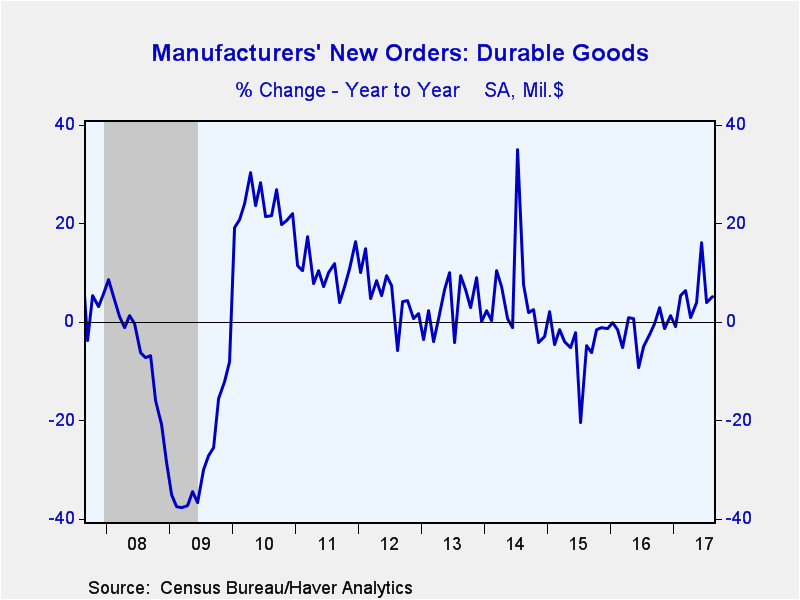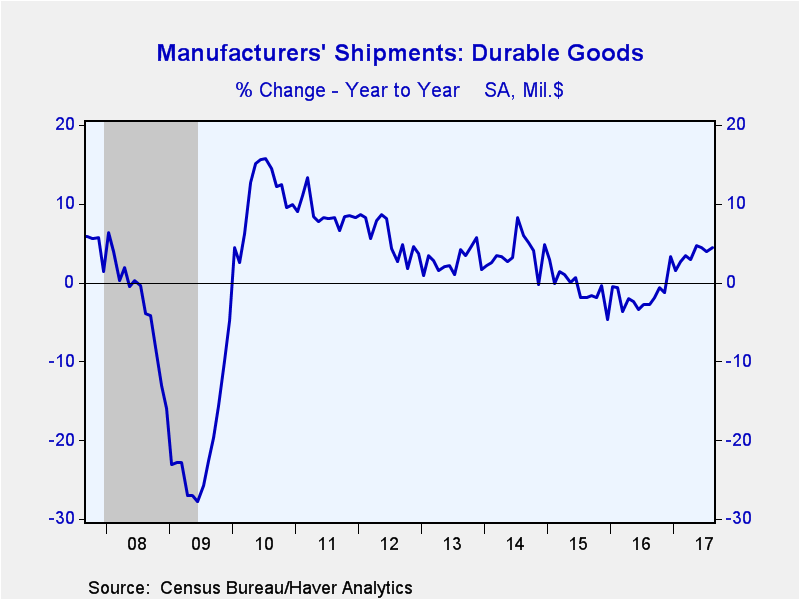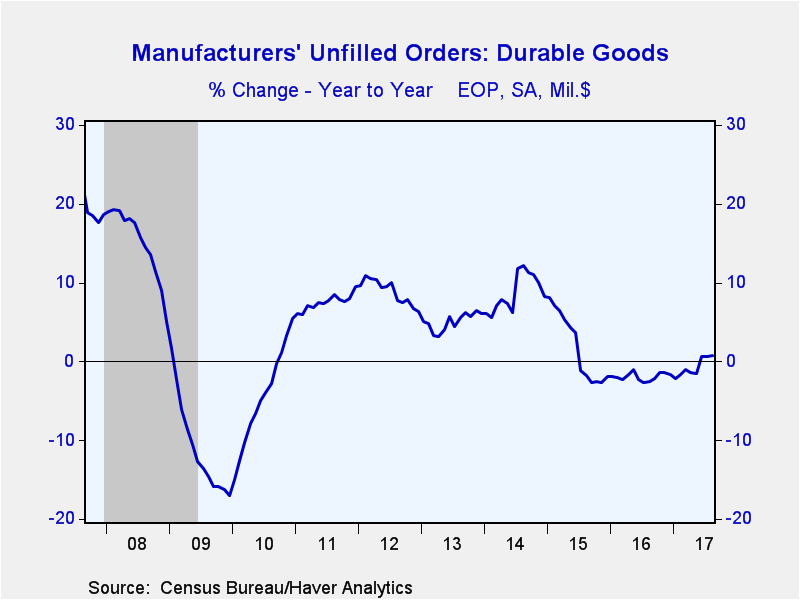 Global| Sep 27 2017
Global| Sep 27 2017U.S. Durable Goods Orders Are Boosted by the Transportation Sector
by:Tom Moeller
|in:Economy in Brief
Summary
New orders for durable goods increased 1.7% (5.1% y/y) during August following a little-revised 6.8% July decline. A 1.0% increase in orders had been expected in the Action Economics Forecast Survey. The rise in orders reflected [...]
New orders for durable goods increased 1.7% (5.1% y/y) during August following a little-revised 6.8% July decline. A 1.0% increase in orders had been expected in the Action Economics Forecast Survey.
The rise in orders reflected strength in the transportation sector where orders rose 4.9% (3.2% y/y) following stability over the prior two months. Nondefense aircraft & parts surged 44.8% and motor vehicle & parts orders gained 1.5% (0.8% y/y). Excluding the transportation sector, durable goods orders improved 0.2% (6.1% y/y) after a 0.8% rise. During the last three months, orders have risen 1.0%, roughly half the three-month growth rates earlier this year.
Machinery orders increased 0.3% (6.9% y/y) after stability in July. Electrical equipment bookings slipped 0.1% (-2.3% y/y) after a 1.7% jump. Remaining strong were orders for computers & electronic products which jumped 1.3% (3.8% y/y), rising 3.4% since May. That strength has been powered by communication equipment orders which rose 4.0% in August and by 5.0% during the last three months. Orders for computers & related products declined 2.3% (+1.6% y/y) last month, but also were up 5.5% in the last three months. Primary metals orders rose 0.3% (13.1% y/y) after a 0.5% rise, and orders for fabricated metals fell 0.4% (+10.1% y/y) following a 0.9% gain.
Nondefense capital goods orders jumped 4.7% due to the increase in civilian aircraft orders. Orders excluding aircraft rose 0.9% (3.6% y/y) after a 1.1% rise.
Shipments of durable goods increased 0.3% (4.5% y/y) last month after a 0.1% uptick. Shipments outside of the transportation sector rose 0.8% (5.7% y/y) after a 0.1% uptick. Unfilled orders for durable goods held steady (0.8% y/y) after a 0.3% decline. Backlogs outside of the transportation sector rose 0.3% (3.9% y/y) after a 0.5% rise. Durable goods inventories gained 0.3% (2.6% y/y) following a 0.4% rise. Outside of transportation, inventories rose 0.5% (4.4% y/y) following a 0.3% increase.
The durable goods figures are available in Haver's USECON database. The Action Economics consensus forecast figure is in the AS1REPNA database.
Why Persistent Employment Disparities Matter for the Economy's Heath from Fed Governor Lael Brainard is available here.| Durable Goods NAICS Classification | Aug | Jul | Jun | Aug Y/Y | 2016 | 2015 | 2014 |
|---|---|---|---|---|---|---|---|
| New Orders (SA, %) | 1.7 | -6.8 | 6.4 | 5.1 | -1.7 | -4.6 | 4.7 |
| Transportation | 4.9 | -19.6 | 19.1 | 3.2 | -3.4 | -6.2 | 8.2 |
| Total Excluding Transportation | 0.2 | 0.8 | -0.0 | 6.1 | -0.7 | -3.6 | 2.9 |
| Nondefense Capital Goods | 4.7 | -19.9 | 20.8 | 8.1 | -7.1 | -11.0 | 0.9 |
| Excluding Aircraft | 0.9 | 1.1 | -0.1 | 3.6 | -4.6 | -4.3 | 0.3 |
| Shipments | 0.3 | 0.1 | -0.0 | 4.5 | -1.6 | -0.6 | 3.8 |
| Unfilled Orders | 0.0 | -0.3 | 1.3 | 0.8 | -1.7 | -2.0 | 8.3 |
| Inventories | 0.3 | 0.4 | 0.5 | 2.6 | -0.7 | 1.6 | 4.7 |
Tom Moeller
AuthorMore in Author Profile »Prior to joining Haver Analytics in 2000, Mr. Moeller worked as the Economist at Chancellor Capital Management from 1985 to 1999. There, he developed comprehensive economic forecasts and interpreted economic data for equity and fixed income portfolio managers. Also at Chancellor, Mr. Moeller worked as an equity analyst and was responsible for researching and rating companies in the economically sensitive automobile and housing industries for investment in Chancellor’s equity portfolio. Prior to joining Chancellor, Mr. Moeller was an Economist at Citibank from 1979 to 1984. He also analyzed pricing behavior in the metals industry for the Council on Wage and Price Stability in Washington, D.C. In 1999, Mr. Moeller received the award for most accurate forecast from the Forecasters' Club of New York. From 1990 to 1992 he was President of the New York Association for Business Economists. Mr. Moeller earned an M.B.A. in Finance from Fordham University, where he graduated in 1987. He holds a Bachelor of Arts in Economics from George Washington University.










